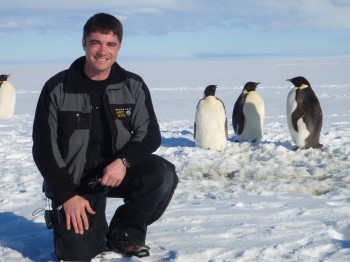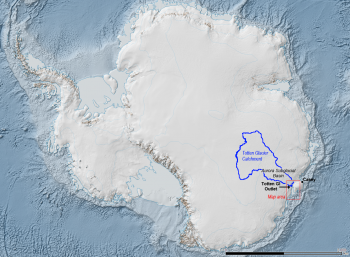Ocean may be Melting Glacier
November 2, 2015

JAMIN GREENBAUM.
Surface & Hydrologic Processes
Researchers at the Institute for Geophysics (UTIG) have discovered two seafloor gateways that could allow warm ocean water to reach the base of Totten Glacier, East Antarctica’s largest and most rapidly thinning glacier. The discovery, reported in the March 16, 2015, edition of the journal Nature Geoscience, probably explains the glacier’s extreme thinning and raises concerns about how it will affect sea level rise.
Totten Glacier is East Antarctica’s largest outlet of ice to the ocean and has been thinning rapidly for many years. Although deep, warm water has been observed seaward of the glacier, until now there was no evidence that it could compromise coastal ice. The result is of global importance because the ice flowing through Totten Glacier alone is sufficient to raise global sea level by at least 11 feet, equivalent to the contribution of the West Antarctic Ice Sheet if it were to completely collapse.
“We now know there are avenues for the warmest waters in East Antarctica to access the most sensitive areas of Totten Glacier,” said lead author Jamin Greenbaum, a UTIG Ph.D. candidate.

The ice loss to the ocean may soon be irreversible unless atmospheric and oceanic conditions change so that snowfall outpaces coastal melting. The potential for irreversible ice loss is due to the broadly deepening shape of Totten Glacier’s catchment, the large collection of ice and snow that flows from a deep interior basin to the coastline.
“The catchment of Totten Glacier is covered by nearly 2½ miles of ice, filling a sub-ice basin reaching depths of at least one mile below sea level,” said UTIG researcher Donald Blankenship.
Greenbaum and Blankenship collaborated with a team from the United States, Australia, the United Kingdom and France.
Because much of the California-sized interior basin lies below sea level, its overlying thicker ice is susceptible to rapid loss if warm ocean currents sufficiently thin coastal ice. Given that previous work has shown that the basin has drained its ice to the ocean and filled again many times in the past, this study uncovers a means for how that process may be starting again.
“We’ve basically shown that the submarine basins of East Antarctica have similar configurations and coastal vulnerabilities to the submarine basins of West Antarctica that we’re so worried about, and that warm ocean water, which is having a huge impact in West Antarctica, is affecting East Antarctica, as well,” Blankenship said.
The deeper of the two gateways identified in the study is a three-mile-wide seafloor valley extending from the ocean to beneath Totten Glacier in an area not previously known to be floating. Identifying the valley was unexpected because satellite analyses conducted by other teams had indicated the ice above it was resting on solid ground.
Seafloor valleys that connect this deep, warm water to the coast can especially compromise glaciers, a process previously known to be occurring along the coast of the West Antarctic Ice Sheet. Complete collapse of the Totten Glacier catchment may take many centuries. The timing is the subject of intensive research.
The UTIG team collected the data during five Antarctic field campaigns using aircraft loaded with equipment to analyze the ice and seafloor in regions that even icebreakers are unable to reach. The airplane was outfitted with radar that can measure ice several miles thick, lasers to measure the shape and elevation of the ice surface, and equipm
ent that senses the Earth’s gravity and magnetic field strengths, which are used to infer seafloor shape.
Back to the Newsletter